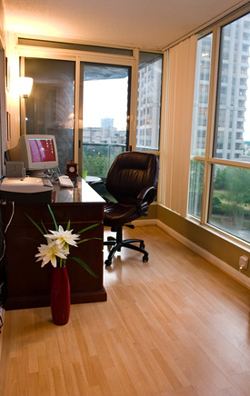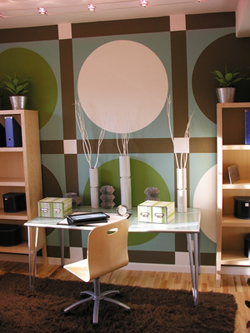
Create your own home office
If you're lucky enough to be able to work from home, then you probably already know how important it is to have the right home office set up. It's amazing how much a work environment can affect productivity and quality of work. A good home office work environment means you'll work more efficiently and will be more likely to enjoy working in your home. Learning how to set up your home office can take a lot of trial and error and hopefully this article will help if you’re starting out or even thinking of starting again!
Where
Choosing the right place for you to work is key in creating the perfect home office. Figuring out exactly where to put your home office is probably one of the toughest decisions to make. Most homes already have a limited amount of free space and trying to fit in even a small office can be difficult. You need to minimise distractions wherever possible so try and choose a room that`s away from a bathroom or other high traffic areas in your home.
Dedicated room
If you already have a room allocated to be your office, then you’re off to a good start.
Attic
Having an attic converted to become your home office could be expensive. You’ll need specialised assistance and advice to ensure it’s possible as it depends on the overall structure of your hours. Just make sure that if you do decide to set up your office in your attic that you have a good ladder or fixed stairs added and that you have enough power points for computer and other office equipment to be plugged in.
Garage or shed
Converting your garage or shed into an office could also be an expensive option as you'll need to make sure it's secure and that it`s properly heated, air conditioned and insulated as well as ensuring power is easily accessible.
Corner of the living room or bedroom
This is probably the simplest and cheapest option but has the disadvantage that you won’t have privacy and quiet if other members of your family are around. Using a corner area lets you take advantage of available space and is well suited if you live in an apartment or smaller residence. Make sure you keep track of where electrical outlets and phone sockets are so that they aren`t blocked or inaccessible by your desk.
Corridor
Often houses have a corridor area that you could take over though most are not large enough. Corridors are usually windowless and having natural light in your office space is of great benefit so try to find an area with at least one window nearby.
Plan your layout

The layout of your home office can affect your work so it is important to get it right.
If you need to buy new office furniture, you should first plan the layout before purchasing any. Sit down with pencil and paper and draw a rough plan of your office space. Measure the area you have and what existing furniture you are going to use. Work out the best place to have your desk and don’t forget to consider natural light.
Remember to note where the power outlets and telephone sockets are. Have a think about what you will need power for – computer, printer, lights, telephone, modem, fax, and telephone charger. The list can get quite long so it might be a good idea to get an electrician in to install more power outlets.
Consider where the door and windows are in relation to where you will be sitting and think about whether or not there be drafts in cold weather or glare on sunny days.
Think about where guests will sit. The ideal would be to have a small coffee table and chair where you can sit together. Where will bookshelves go? All offices require somewhere to store books, manuals, folders etc. If you don’t already have one it might be a good idea to have one built in or clear out an existing wardrobe and use that.
Heating and A/C are important factors in your layout. If there is a window, you may get excessive heat during the summer so a blind may be required. If you have an a/c vent, make sure you are not sitting directly under it as you may find it too cool.
One great part about setting up your own office space is that you get to pick the colours. See this article on choosing a colour for your home office. For finishing touches, add pictures, wall hangings, artwork, plants and consider adding small shelving for ornaments as it adds atmosphere and can also be practical.

How to get started
- Remove all existing furniture and plants from the room or space that has been allocated
- Clear out any cupboards or shelving
- Install any new power or phone sockets and new shelving while the area is empty
- Do any makeover work required - i.e. painting, cleaning etc.
- Start bringing the larger pieces of furniture in first so you`ll have a larger amount of floor space to move them around
- Install the office equipment and place it where it needs to go in the room. Make sure that all cables are long enough to reach power sockets.
- Connect and test all equipment to make sure everything is working properly, and that you haven`t overloaded the circuits
- Sit in your desk chair and check the basics such as glare from a window, or inadequate lighting on your desk
Remember to always be on the lookout for ways you could change things around to make your home office space work better for you. If you find you are constantly knocking your leg on the coffee table or it's difficult to access files in the cupboard because a chair is in the way, then it’s time to move things around again. Be adventurous - after all, it is your office!
